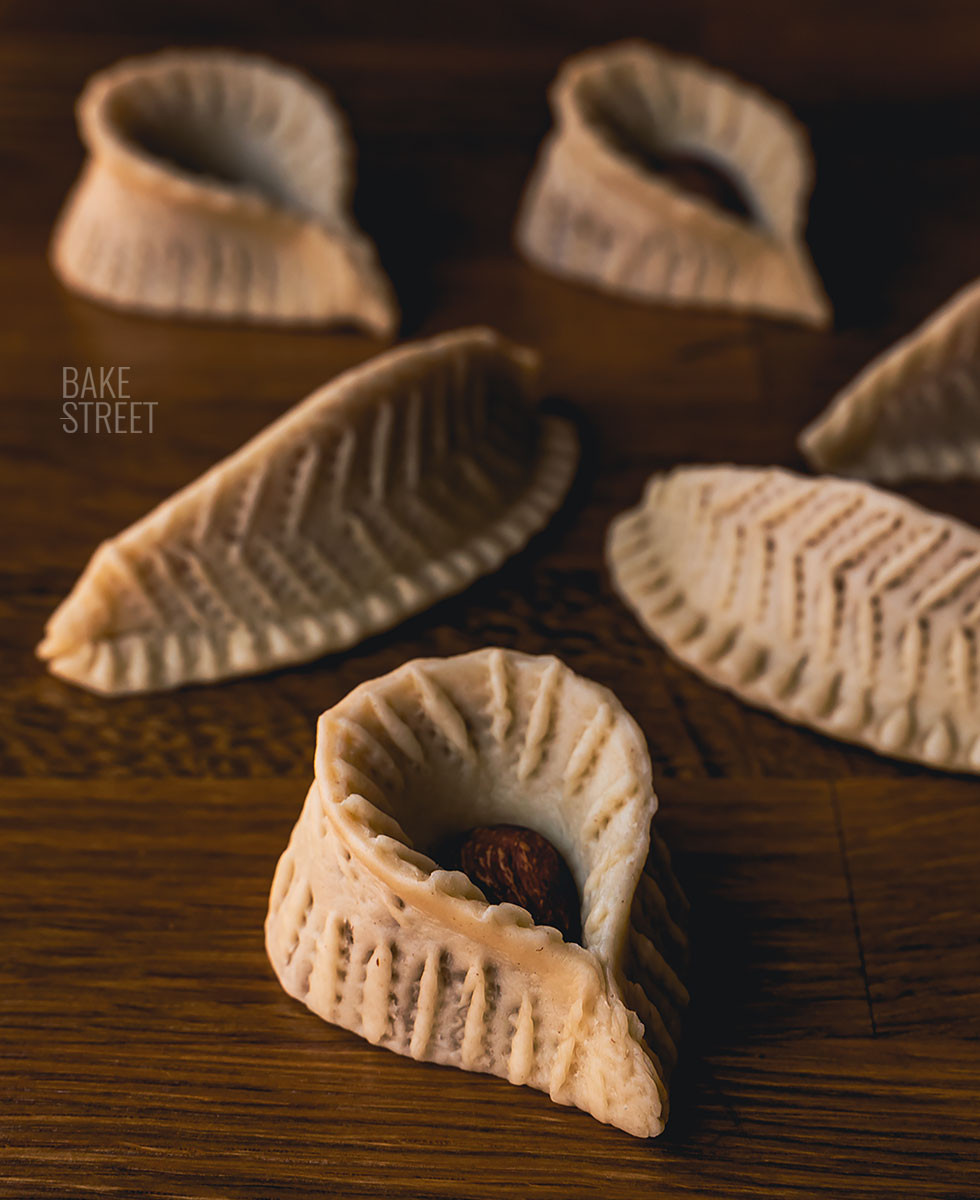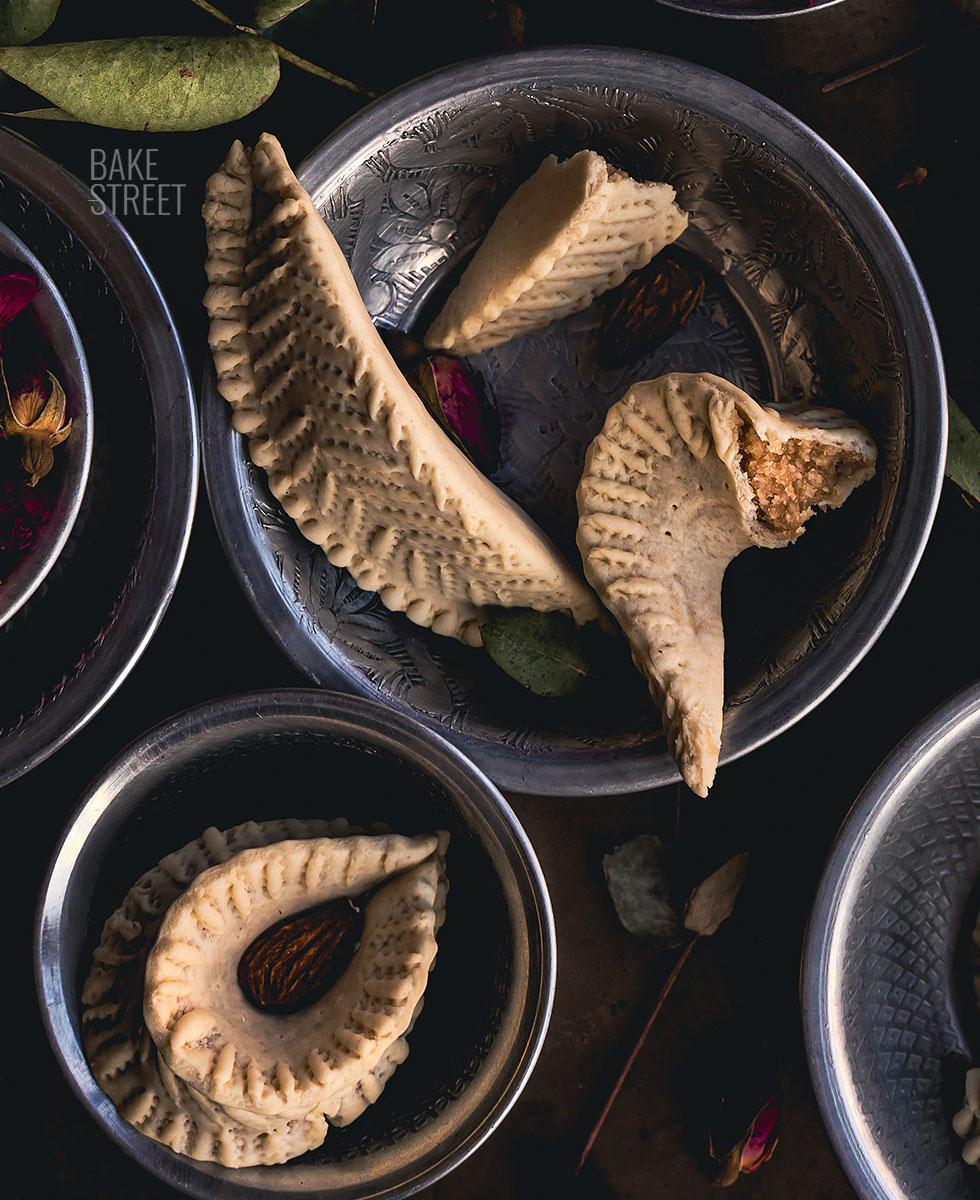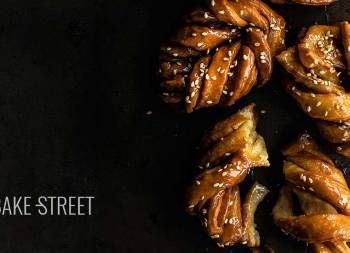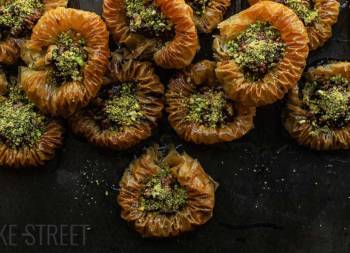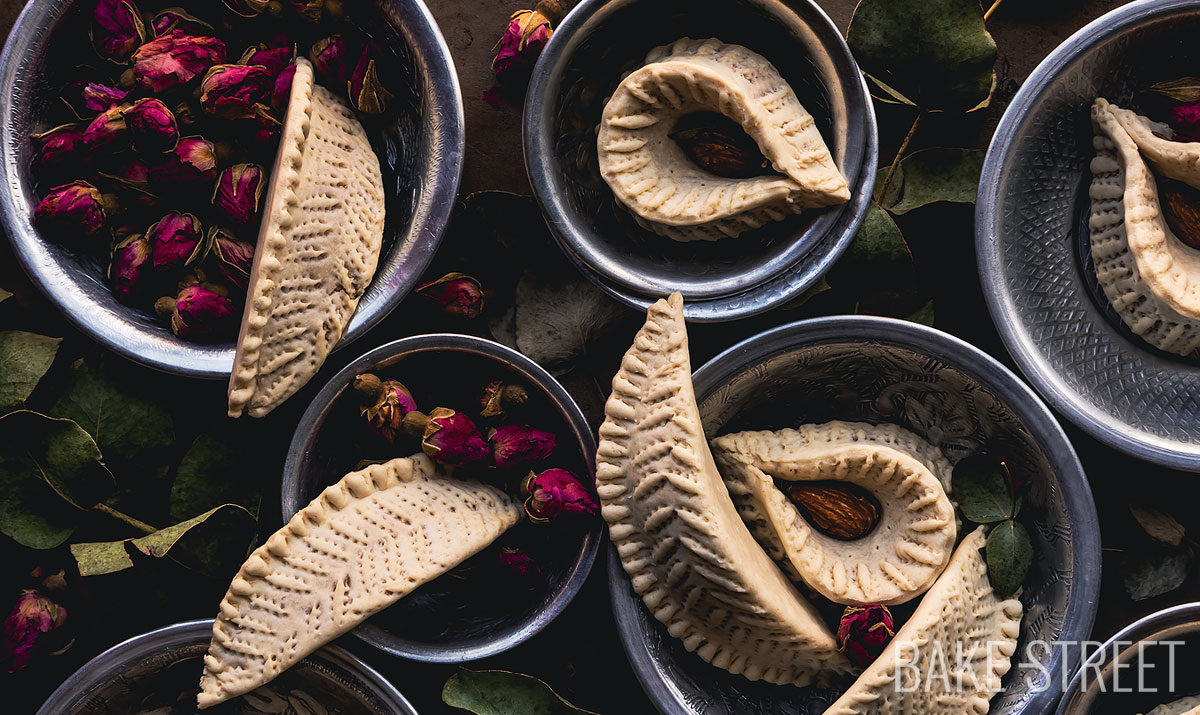
Kaab El Ghazal – Gazelle Horns
I believe that, without a doubt, one of the most aromatic and elegant pastries that we can enjoy is everything that surrounds Arabian gastronomy. I have already told you about it on occasion, but I do it again. Today I expand my repertoire with this recipe for Kaab El Ghazal – Gazelle Horns.
Just the name alone makes me fall in love…. I find it beautiful and very original. But when we see this wonderful elaboration, it is almost impossible not to fall in love with it. It is incredible how with only two elements; flavored almond paste and a very simple dough, we can achieve a piece that could almost be jewelry. I love the care and detail that they invest in all their creations.
Although at first it may seem a complicated preparation, you will see that it really is not. Its decoration and shape makes the final result impressive and very elegant, but in reality it is a portion of almond paste, covered with a fine dough that we will later texturize with the help of a crimpet. This is where we create that impressive final finish.
Then we will have to let the pieces dry to finish cooking them for a short period of time. And that’s all. A perfect recipe to surprise at coffee time, or perhaps better with a mint tea (atay bi naa’ naa’), and that we can leave prepared in advance.

Kaab El Ghazal – Gazelle Horns origin.
On this occasion, I have found hardly any information about the history or origin of these small sweets originating in the Maghreb. This is something that happens with many pieces of Moroccan pastry and the reason for this is that Moroccan gastronomy is a mixture of the culinary art of Berbers, Jews and Andalusians, besides having a European touch due to the French colonization.
This pastry is a favorite in Morocco, Algeria (they call them Tcharek) and Libya (they call them kaak halkoom) and it seems to be a variant of sambusak. The name kaab el gazhal, is often mistranslated as “gazelle horn“, most probably because besides being a much more attractive name, its elongated crescent-shaped appearance is reminiscent of the horns of this animal. Actually, the correct translation would be “gazelle’s heel“.
In France they are called “Cornes de Gazelles”
Kaab, a cognate of the Hebrew word ahkaiv, is the source of the name Yakov or Jacob who was born clutching the heel of his twin brother, as well as referring to a heel, denotes something bulging or protruding, which in this case would be the filling.
The dough, in its origins, was made with smen(salted, fermented, clarified butter made with sheep’s milk) although nowadays it is common to find elaborations in which a portion of butter is used directly or, even in some occasions, vegetable oil. The filling is a slightly sweet and flavored almond paste.
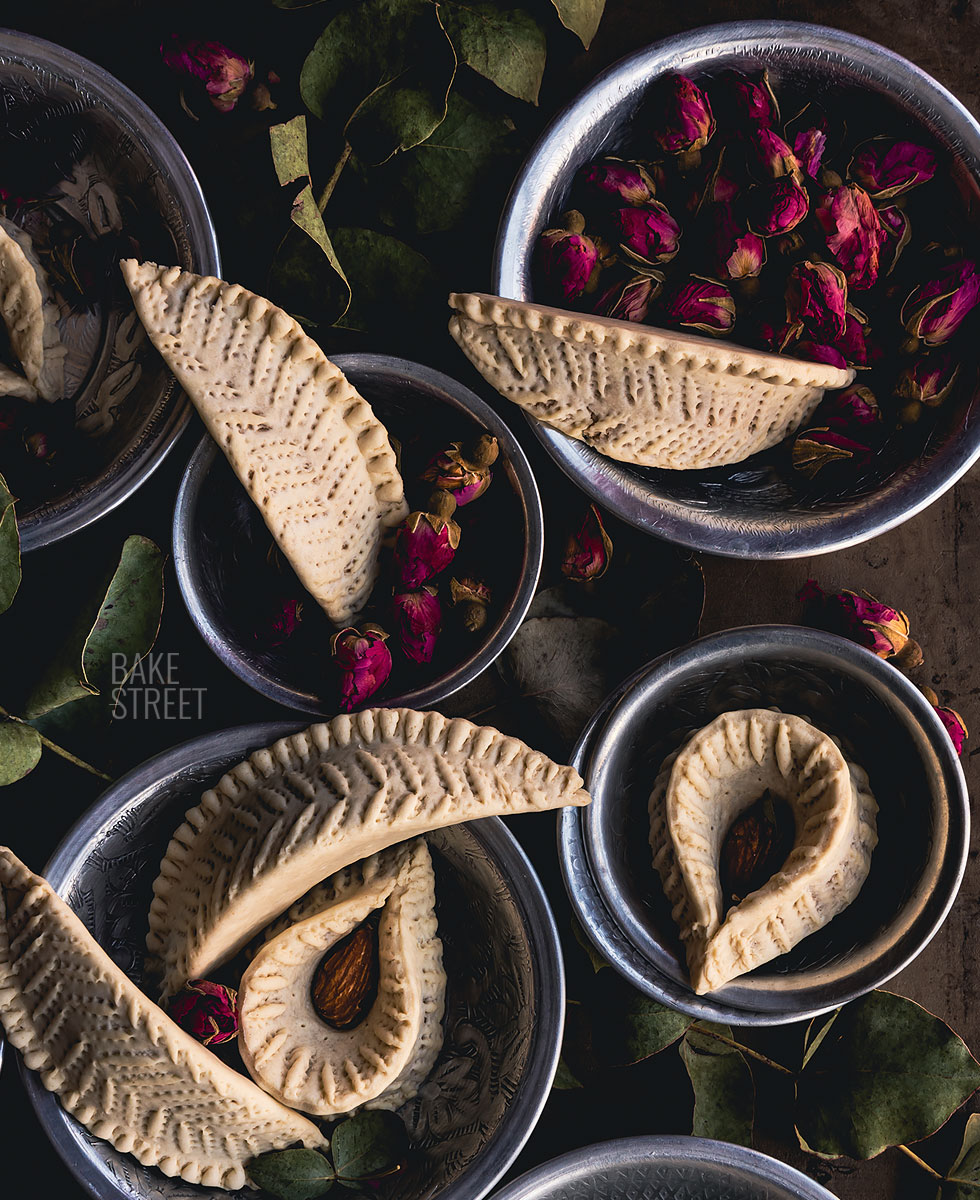
Delicacy.
As I mentioned before, the Moroccan pastry (Arab in general) is surprisingly creative and elegant, they spend a lot of time to the elaboration of each of the pieces and we can clearly appreciate the love and care they invest in each of them. But not only professionals, many housewives are true artists and keep alive this culture and creation of pieces of edible goldsmithing or ephemeral art.
Ka’ab al-Ghazal, Kaab El Ghazal or Gazelle Horns as it is mostly known by us, is a thin dough filled with a paste of ground almonds flavored with flower water that is prepared on Eid.
There are two Eid holidays throughout the year: Eid Al Fitr and Eid Al Adha.
Eid Al Fitr (meaning “the festival of the end of fasting“) is an important date in the Islamic calendar celebrated by Muslims around the world, marking the end of Ramadan and the beginning of Shawwal (the tenth month in the Islamic lunar calendar).
Eid Al Adha(it could be translated as “Celebration of Sacrifice“) also called Aid Al Kebir (Great Feast). This holiday, whose date is not fixed with respect to the Gregorian calendar or the seasons, takes place on the tenth day of the month of Zil-Hajj, which is 70 days after Eid al-Fitr. Eid al-Adha is part of the Hajj, the great pilgrimage to Mecca, which must be performed at least once in a lifetime during this month. It is considered the “Eid of greater importance” of the two. It lasts four days from the tenth day of Dhu Al Hijjah (the twelfth and last month of the Islamic lunar calendar).
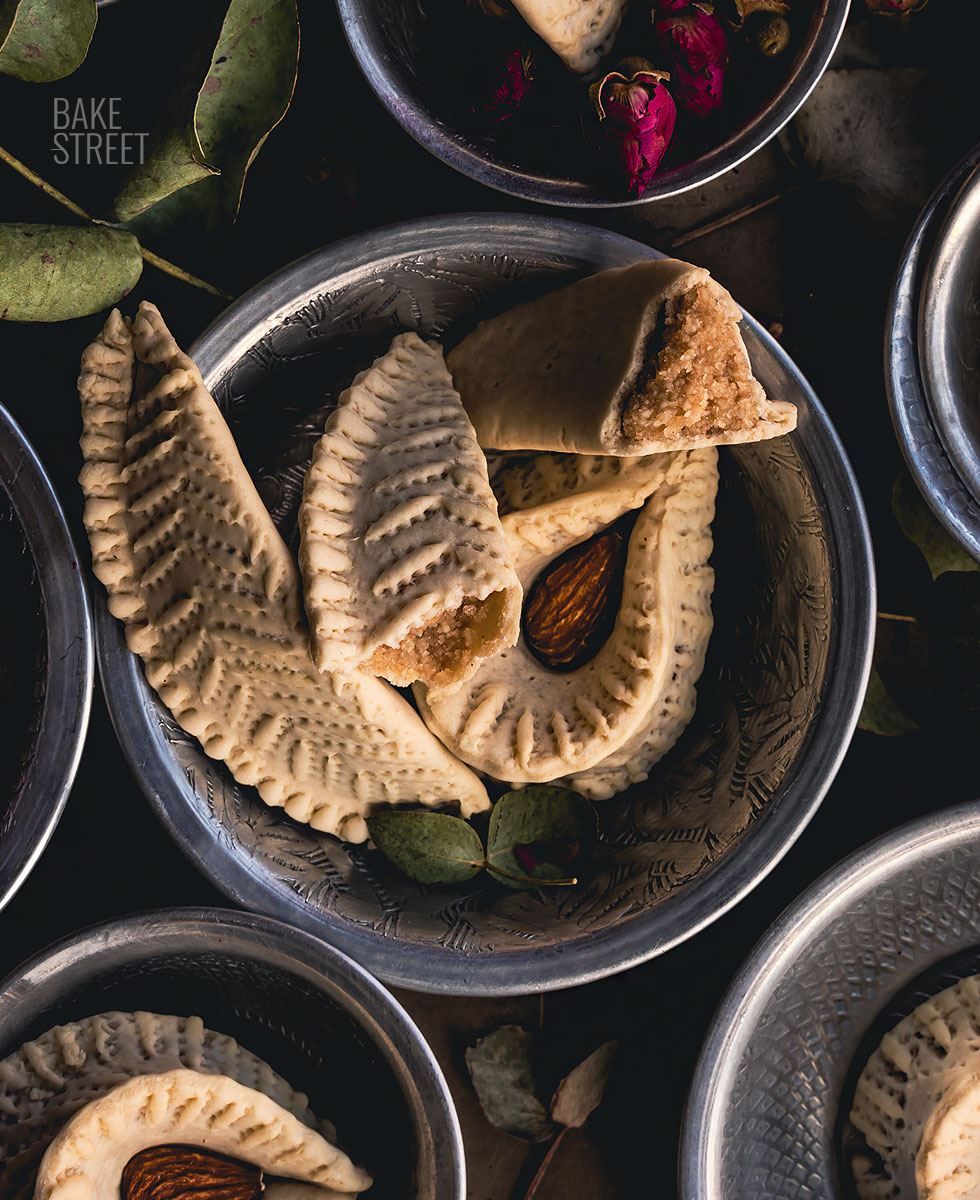
“Ka’ab” takes the form of a crescent moon.
It is then artistically decorated. They are then baked at low heat for a short period of time and served. They are sometimes stored individually in clear plastic bags and sealed with a gold seal or silver ribbon and placed on a tray.
Kaab Al-Ghazal or Gazelle Horn, which is considered the origin of all almond sweets in Moroccan confectionery, being the finest and most popular sweet of all.
Recipe Kaab El Ghazal - Gazelle Horns
Ingredients for 10 pieces
Recipe based fromCocina con Omm Tarik
DOUGH:
- 125 g wheat flour (9% protein)
- 15 g powdered sugar
- 30 g unsalted butter at room temperature
- 40 g orange blossom water
- 5 almonds with peel (optional)
FILLING (ALMOND PASTE):
- 125 g ground almonds
- 63 g powdered sugar
- 10 g unsalted butter at room temperature
- cinnamon to taste, about a little less than 1/2 teaspoon
- 17-20 g orange blossom water
- 2 pebbles (about 1 g) of gum arabic, pulverized or crushed or, failing that, we can use 5 g glucose or 5 g of honey
MATERIAL WE WILL NEED:
- bowls
- scraper
- rolling pin
- pasta machine, optional, but recommended
- perforated tray
- perforated mat
- pasta cutter
- crimper or toothed cake decorating pliers
- a new needle
Instructions
FIRST DAY
Prepare the dough for the gazelle horns.
- In a bowl add the flour together with the powdered sugar and butter. Mix lightly with the help of a silicone spatula.
- Start adding the orange blossom water little by little and mixing at the same time. In my case I have been able to add 40 g of orange blossom water, but it will depend on the absorption capacity of your flour. This quantity can vary (being slightly higher or lower).
- We must obtain a soft dough, not sticky and very pleasant to handle. Important, it must not be dry either, when kneading, we must be able to do it easily and the dough must adhere to itself without leaving folds.
- Knead for a few minutes until the gluten has almost developed.
- Round, flatten slightly, cover with film and refrigerate while preparing the filling.
Prepare almond filling.
- Incorporate ground almonds together with the powdered sugar in a food processor. Process, just for a few seconds, so that both elements are well integrated and pulverized. We should not process for a long time, otherwise and due to the friction of the blades, we will remove the oil from the almonds.
- NOTE: In case of using gum arabic, grind with pestle and add to the almond and powdered sugar mixture just before processing.
- Transfer the mixture into a bowl and add the butter together with the cinnamon and the glucose or honey (in case you have not used gum arabic). Mix.
- Begin to incorporate orange blossom water little by little and mixing at the same time. We must obtain a manageable almond paste that does not crumble (or not too much).
- Shape a ball and let it rest for 30 minutes.
- After this time, divide the almond paste into 10 pieces of approximately 20 g each.
- Shape into a slightly elongated ball and cover with plastic wrap to prevent it from drying out.
Shaping gazelle horns.
- Take the dough out of the refrigerator, it will only have acquired a little firmness, it should not be hard.
- With the help of a scraper, cut 1/3 of the dough. Keep the rest covered with plastic wrap to prevent it from drying out.
- Flatten with the help of a rolling pin, enough to be able to pass it through the pasta machine.
- Once we pass it through the pasta machine, close it like a triptych, flatten it again with the rolling pin and pass it again through the pasta machine. We will do this step a couple of times. To give the final thickness to the dough I have used level 2, ideally the dough should be thin, but without overdoing it so that it does not break when handling it or when forming the gazelle horns.
- Place the dough on a clean work surface. If you wish, you can stretch it a little more with the rolling pin.
- On it, place a piece of marzipan (previously thinned and curved, as I show you in the video) and cover with the dough, making sure that there is excess behind the piece of marzipan.
- Adjust the dough well to the piece of marzipan (making sure there are no air pockets), and finish refining and shaping. In my case, I have given it a little more length than it had originally.
- With the help of a pastry cutter, cut the dough leaving a small border and make sure the ends are well sealed.
- With the help of a crimpet or toothed decorating pliers, texturize the outside. We will do it only on one side (we will create a zig zag) and on the edge of the dough.
- Place on a tray lined with a perforated mat, silpat or Teflon.
- Shape the rest of the pieces in the same way as this first one.

Another type of shaping.
- Originally the gazelle horn is as I have shown you the previous process. But thanks to this woman who shares her recipes on Youtube, I was able to see this beautiful shaping that she carries out being the beginning of the process identical to the gazelle horn.
- Place the dough on a clean work surface.
- On it, place a piece of marzipan (previously refined and curved, as I show you in the video) and cover with the dough making sure that there is excess behind the piece of marzipan.
- Adjust the dough well to the piece of marzipan (making sure there are no air pockets), and finish refining and shaping. In my case, I have given it a little more length than it had originally.
- With the help of a pastry cutter, cut the dough leaving a small border and make sure the ends are well sealed.
- Very carefully, join the ends of the piece as if we wanted to create a horseshoe. In this step, we must leave the fold that we have cut with the pastry cutter upwards. So that the result is like a ruffle.
- Join both ends and seal well.
- With the help of a crimpet or toothed decorating pliers, texturize the outside of the piece and the top inside, as I show you in the video.
- Place an almond with skin in the central part, where we will have left a small hole.
- Place on a tray lined with a perforated mat, silpat or Teflon.
Rest.
- Once our pieces are shaped, we will have to let them dry overnight at room temperature.
- Cover them with a cotton cloth to prevent dust from falling on them. Our purpose is that the outer dough hardens.
THE NEXT MORNING
Bake.
- Preheat the oven to 340ºF/170ºC with heat up and down.
- Using a new needle, prick the base of each piece and the sides (as shown in the video). Since the outer dough is hard and dry, we need to create "escape routes" for the steam that will be released during baking to prevent the pieces from cracking or bursting.
- Bring to medium high and cook for 12-14 minutes. The gazelle horns will be white, they should not brown.
- Remove and let cool completely on a wire rack.
- Serve.
- NOTE: Some preparations suggest that, once baked and cooled, they are dipped in orange blossom water and then dipped in powdered sugar. Others simply sprinkle them with powdered sugar. In my case, I left them as they came out of the oven.

Notes
- The quality of the almond will influence the flavor and final result. The better it is, the better our final product will be.
- In case you do not like cinnamon, it can be omitted.
- Gum Arabic is extracted from the resin of certain varieties of Acacia. It is an ingredient that we must integrate, previously pulverized, and it will help to make the final texture more elastic. It is used as a thickener or emulsifier. In case it is not available, we can replace it (although the result is not the same) with glucose or honey.
- The quality of the orange blossom water is also very important to achieve a good aroma and final flavor.
- If we do not like orange blossom water or we want to aromatize in another way, we can use rose water.
- If we make the almond paste a few days in advance, we will help the flavors and aromas to intensify. In this case, wrap it well in plastic wrap and keep it refrigerated until ready to use. You will have to temper it to be able to work well with it.
- The flour I used for the dough is common wheat flour with 9 g of protein. Remember that if we vary the type of flour, this will directly influence the absorption capacity. This will make our dough need more or less hydration. This step we will be able to value it as we add the hydration and knead.
- The pasta machine is not essential, but it does help us to achieve a uniform thickness, besides being able to refine the dough quite a lot. In case of not having it, we can stretch with a rolling pin until obtaining a thin dough that allows us to work well with it.
- For outside decoration, originally, crimpets or serrated decorating pliers are used. There are many models available to create different patterns. In my case, I don't have any (I got lost in this step) and I used ice tongs that have serrated ends and allowed me to texturize the pieces.
- If you do not have crimpets or other similar utensil, we can always use tweezers and create a textured or pattern to our liking.
- The final drying of the gazelle horns will ensure that we obtain a very crispy texture on the outside and tender and moist on the inside.
- We must prick the pieces before baking them. Do not forget this step to prevent them from cracking or bursting during baking.
- This type of pastry should have a light color after baking. Do not brown or toast them.
- If you wish, you can sprinkle the pieces with powdered sugar after baking and cooling them, and then rub them carefully to encourage the powdered sugar to remain in the textured holes.
- Its flavor improves when it has rested for 1-2 days.
- They can be kept in an airtight container for 15-20 days.

If you like Arab pastries, you can not miss this marvel that, surely, many of you already know and have tasted on several occasions. Kaab El Ghazal - Gazelle Horns.
Of all the process the most "laborious" part is the one that we will dedicate to the exterior decoration. It is not that it is laborious as such, but it will be the part that will require more time if we want them to be beautiful and attractive. Undoubtedly, it will be worth each and every one of the minutes that you have dedicated to it.
I hope you will try them and let me know how they turned out.
I wish you a wonderful weekend!
Lots of love,
Eva
Sources: Books Google, Erem News
